WHAT IS LIFE?
Life is all around us. Dive into the deepest bottom of the ocean, climb the highest mountains of the world or simply stay where you are. The entire Earth swarms with billions and billions living organisms. However, the vast majority of life is invisible to the naked eye and can be found on places you would have never expected. Wherever you are right now, it is almost certain that each square centimeter of all objects around you is inhabited by many primitive bacteria, miniature fungi and other various creatures. Every time you go to bed, you can say hello to the hundreds of thousands of tiny dust mites, who made your bed their permanent home. Or you can get acquainted with billions of microorganisms living on the surface of your body – on each of us, there are actually more organisms than there are people on the entire planet.
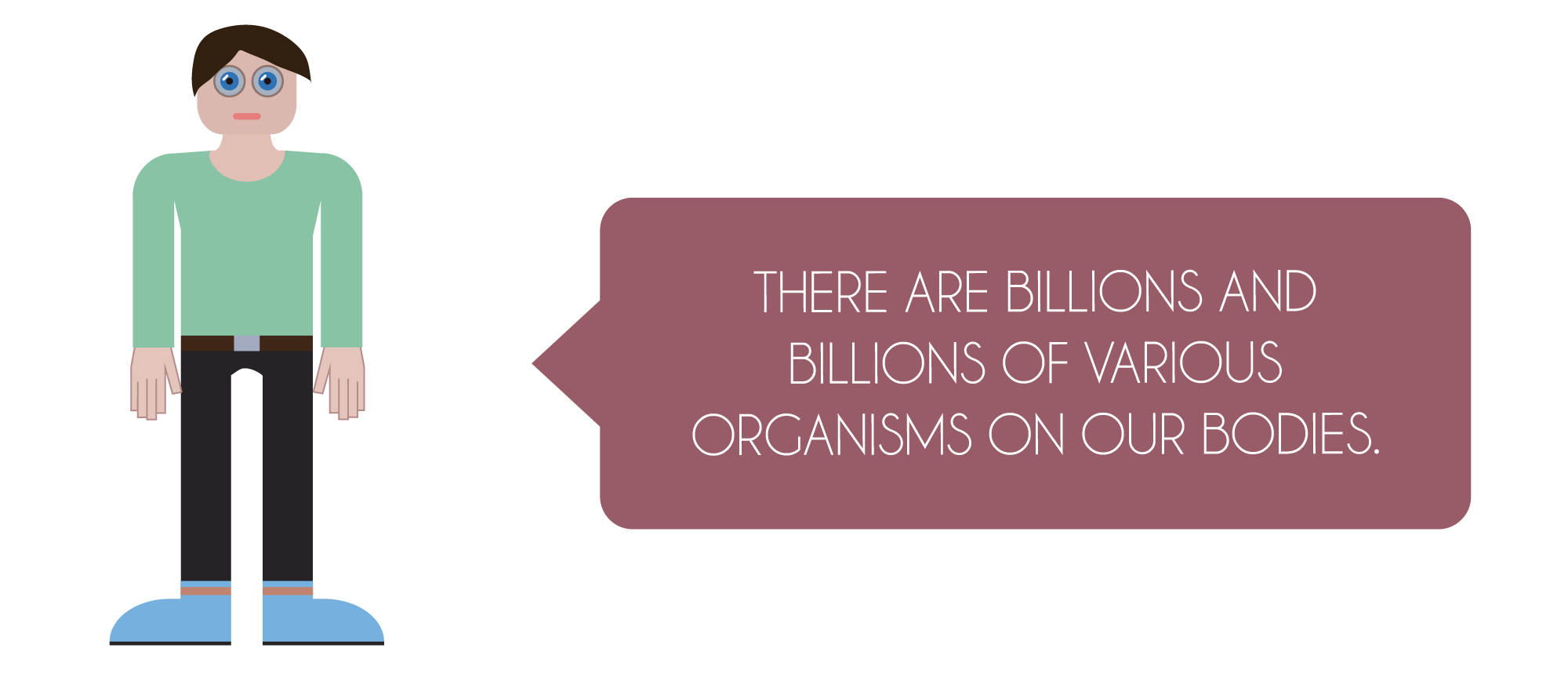
Considering how incredibly common life is here on Earth and how often we encounter it, we know ruefully little about it. Scientists estimate that our planet is a haven for staggering several million species. However, as of today we are acquainted with “just” one million organisms. That is to say that the majority of all organisms who are sharing this tiny planet with us have never been observed and are still awaiting their discovery.
However, science has to deal with another issue – the effort to describe what life actually is. Defining life has turned out to be much more complicated than it might seem at first glance. It is difficult to find a common defining element for all objects we consider to be alive when they are so different from each other – you would hardly find a similarity between a human and a dandelion.
But there is one thing we know for sure. Life is, just like everything else, part of the universe, so it has to obey its laws. In its essence, every living organism is just a collection of complicated molecules arranged in a unique way that makes the organism what it is. In other words, life is not anything magical as people used to think – on the molecular level, it is composed of the same inanimate stuff as everything else.
And scientific research seems so suggest that all of this applies to the species Homo sapiens as well. For millennia, humans have considered themselves to be something more than other organisms, which is actually not that surprising. In a way, we are a unique species – we can communicate using complex languages, create art, build magnificent structures, and many more things other organisms could only dream about. Therefore, it should not be startling for us that people living before the scientific epoch presumed that we must be special and superior to everything else. But is seems that science conveys an entirely different message. Just like all other organisms, we are a product of evolution. And just like all matter in the cosmos, we are composed of atoms and molecules. In other words, you, a dust mite in your bed, and a favorite toy from your childhood are more similar than you might think.
Today, life is defined somewhat clumsily by the following features – every living organism is composed of one or more cells, reproduces, uses energy to its maintenance, grows, adapts to its environment and is subject to evolution.
But right at the first feature (life is composed of cells), we come upon a problem. This problem is brought by objects known as viruses, notorious for causing lots of diseases. Viruses are actually not composed of cells – most of them are much smaller than even the simplest prokaryotic cell. But are they alive, or do they belong into the inanimate world? To answer this question, we first need to learn a bit more about them.
The origin of viruses has been a mystery for many years. Some scientists have long assumed that they originated independently of cells. That is actually not very unreasonable – viruses and cells are nothing alike. Viruses only consist of a tiny package of genetic information wrapped into a membrane. On top of that, they are, unlike cells, unable to extract energy from their environment. You may wonder – how do they survive, then? The answer is simple – they parasite inside cells.
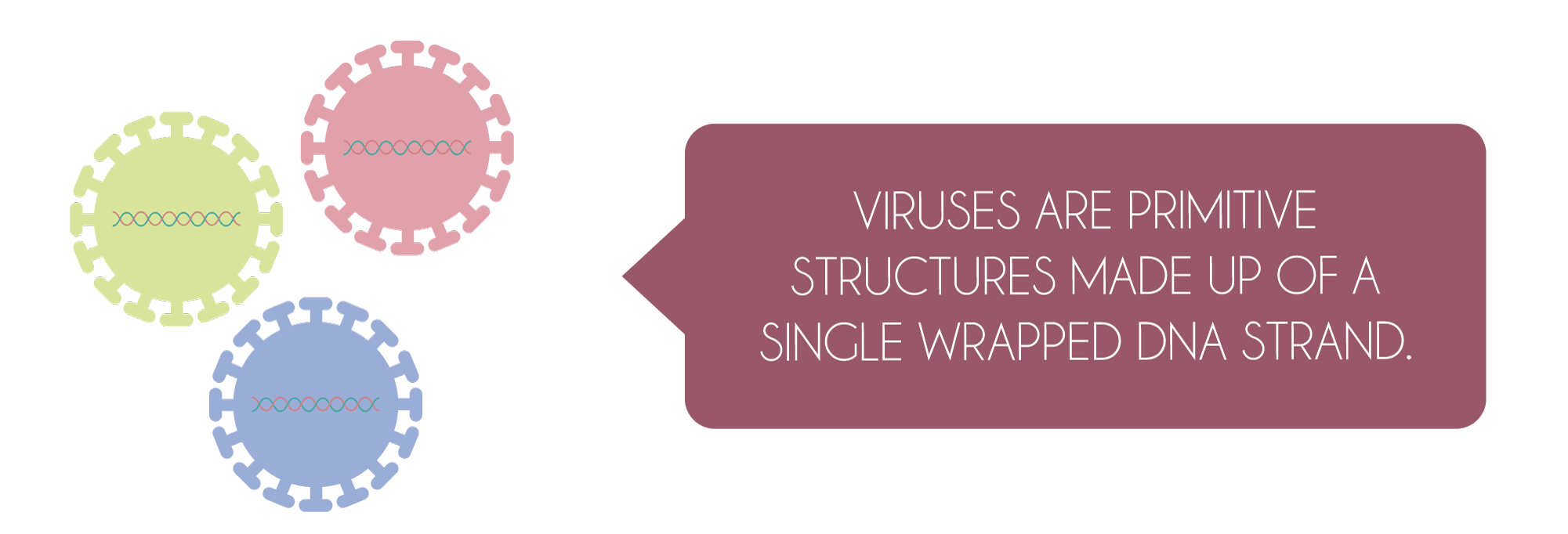
Every single virus has only one task – to find a cellular host and transform it into a factory making thousands of additional such viruses. Those then leave the host, find a different cell and the whole process repeats.
However, the perception of viruses has changed recently, as several gigantic viruses have been discovered – Mimivirus, Megavirus, and more. The existence of these viruses has been a huge surprise for scientists. Imagine that you devote your whole life to the study of rodents and that you know nearly everything there is to know about them. But suddenly, a monstrous mouse as big as an elephant you did not even know existed walks into your house. Similar surprise struck scientists upon discovering giant viruses. Some of these viruses are even bigger than the smallest prokaryotic cells. And what is more, their DNA is often very similar to that of cells.
This discovery has led scientists to a fascinating idea – what if viruses were not created independently, but gradually evolved from cells by throwing away genetic information? What if all of today’s viruses are just very distant descendants of ancient cells that have decided it would be better to sponge on others? That would certainly explain the existence of giant viruses – they are former cells that have not managed to throw away as much genetic information as their smaller cousins.
Viruses are therefore just a miniature package of DNA which is unable to exist independently and parasites on other living organisms. And now we are finally getting close to answering the complicated question as to whether we can consider them alive. Viruses are able to reproduce and utilize energy, but they cannot achieve that on their own. Instead, they use a cellular host. That is why they are considered to be somewhere on the divide between animate and inanimate – some peculiar half-alive objects.
However, there is one more thing that viruses and cells have in common – genetic information in the form of the deoxyribonucleic acid or DNA. Perhaps it cloud even be said that DNA represents the most important compound of life. This fascinating substance contains every single information necessary to build an organism. If you managed to get the DNA of any person in the world, you would know everything about their anatomy (provided that you were able to decode that DNA).
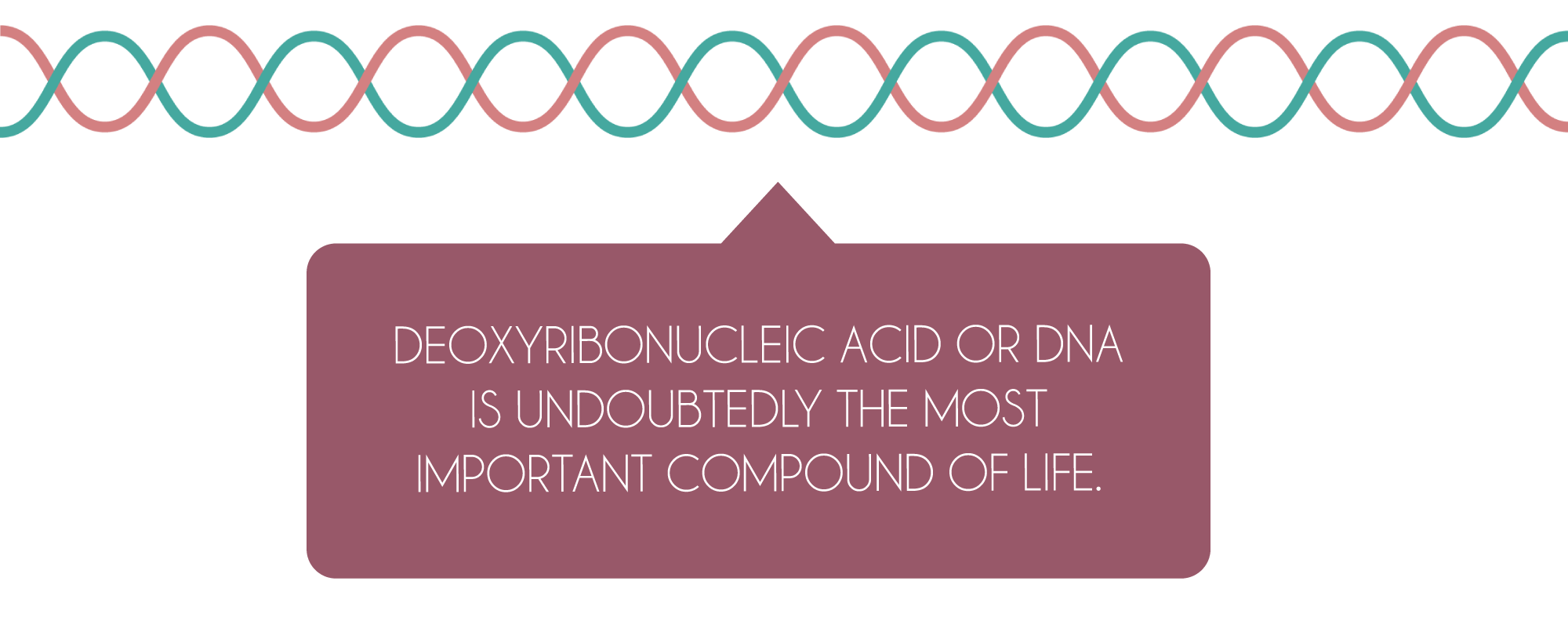
There is a unique DNA in each of us. And not just once – every single one of the billions of cells in your body has a built-in copy of your DNA inside of its core. And it dutifully follows everything the all-powerful DNA says. If we proclaimed that a cell is a kind of organic hardware, DNA could be viewed as its directing software. And these two key components combined are responsible for the existence of me, you and all living things.

 |
NEXT |
THE MARVELOUS STORY OF LIFE
If you were ever presented with the opportunity to travel back in time, it would definitely not be a very good idea to travel to the ages of the early Earth. After its formation, our planet was a huge torrid ball of molten rocks and a poisonous atmosphere. On top of that, it was constantly bombarded with a tremendous number of meteorites. It goes without saying that in such inhospitable conditions none of us would have survived for more than a few seconds.
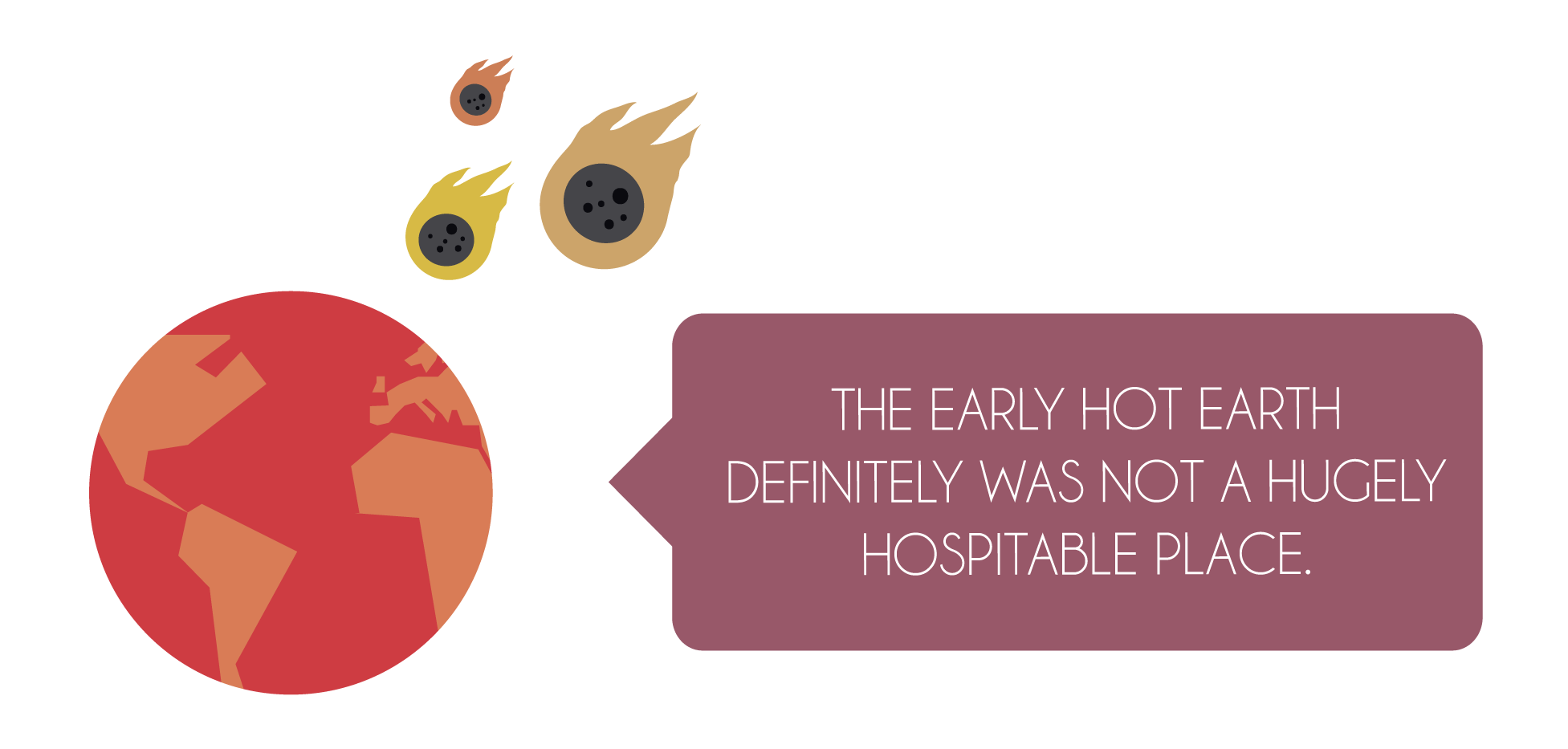
However, something fascinating happened 3.8 billion years ago – the temperature of the Earth dropped below 100 degrees Celsius (212 degrees Fahrenheit) for the first time in history and thus made possible the existence of one of the most crucial compounds for today’s life on Earth – water in its liquid form. Our planet was flooded with oceans and got its typical blue color. And at least in one of those early oceans, the strangest and most mysterious event of all time occurred – the first organisms were created.
To understand why the dawn of life is such a mystery, we first need to know than even the earliest and most primitive organisms were still much more complicated than everything else that could be found on the early Earth. It is a huge mystery how something so complicated could have formed by itself.
Today we know that terrestrial life is based on organic compounds. For instance, the musculature of the human body is made of organic compounds called proteins, which consist of amino acids. But the problem is that proteins in today’s organisms are incredibly complicated – some of them are composed of hundreds of amino acids that have to be stacked in a precise order. It is nearly impossible (or at least immensely improbable) that such complicated proteins were created on the early Earth just by chance. It would have been as if you thoughtlessly threw all sorts of material necessary to construct a car on a pile and expected the car to miraculously build itself.
Today’s complicated organic substances simply could not have been created by accident. They must have evolved from simpler compounds. But today nobody knows how. And now, we are finally getting to the first organism on Earth.
Unfortunately, nobody knows what the first living organism looked like. Quite possibly, it was just a simple molecule, but that molecule differed from the other ones quite significantly – it was able to make copies of itself. We do not know what this molecule looked like. A plausible candidate is RNA or ribonucleic acid, but even that is fairly complicated to be created by accident. Who knows, perhaps we will never find out the true shape of the first “living” molecule.
Whatever the case, this first replicating compound was eventually replaced by our old friend DNA. It wrapped itself into a protective shell (cell wall) and the first cell similar to today’s prokaryotic cells saw the light of day. And then, the most significant and most fascinating mechanism of life came into action and created every single living organism that today merrily roams the face of the Earth – evolution.
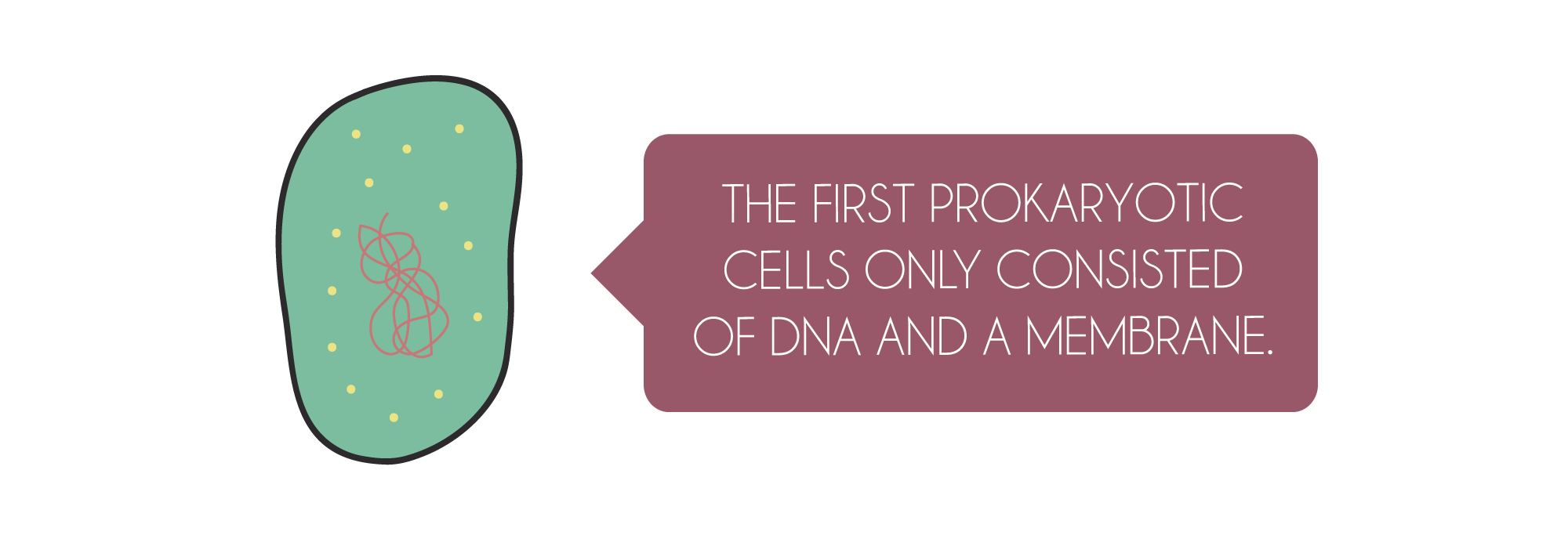
DNA determines the exact appearance of every living organism. Your DNA tells your cells how to behave – the cells in your nails are supposed to obediently divide, the protective cells of your immune system should vigilantly look for unwanted visitors, and red blood cells’ task is to transport oxygen throughout your entire body and thus keep it going. Every organism is just a collection of tiny cellular servants who obediently perform everything the all-powerful DNA orders them. When your DNA says that you are supposed to have brown eyes, the cells in your iris are required to make it happen by producing a large amount of a pigment called melanin. When your DNA thinks it would be a better idea to have blue eyes, the cells produce a bit less melanin.
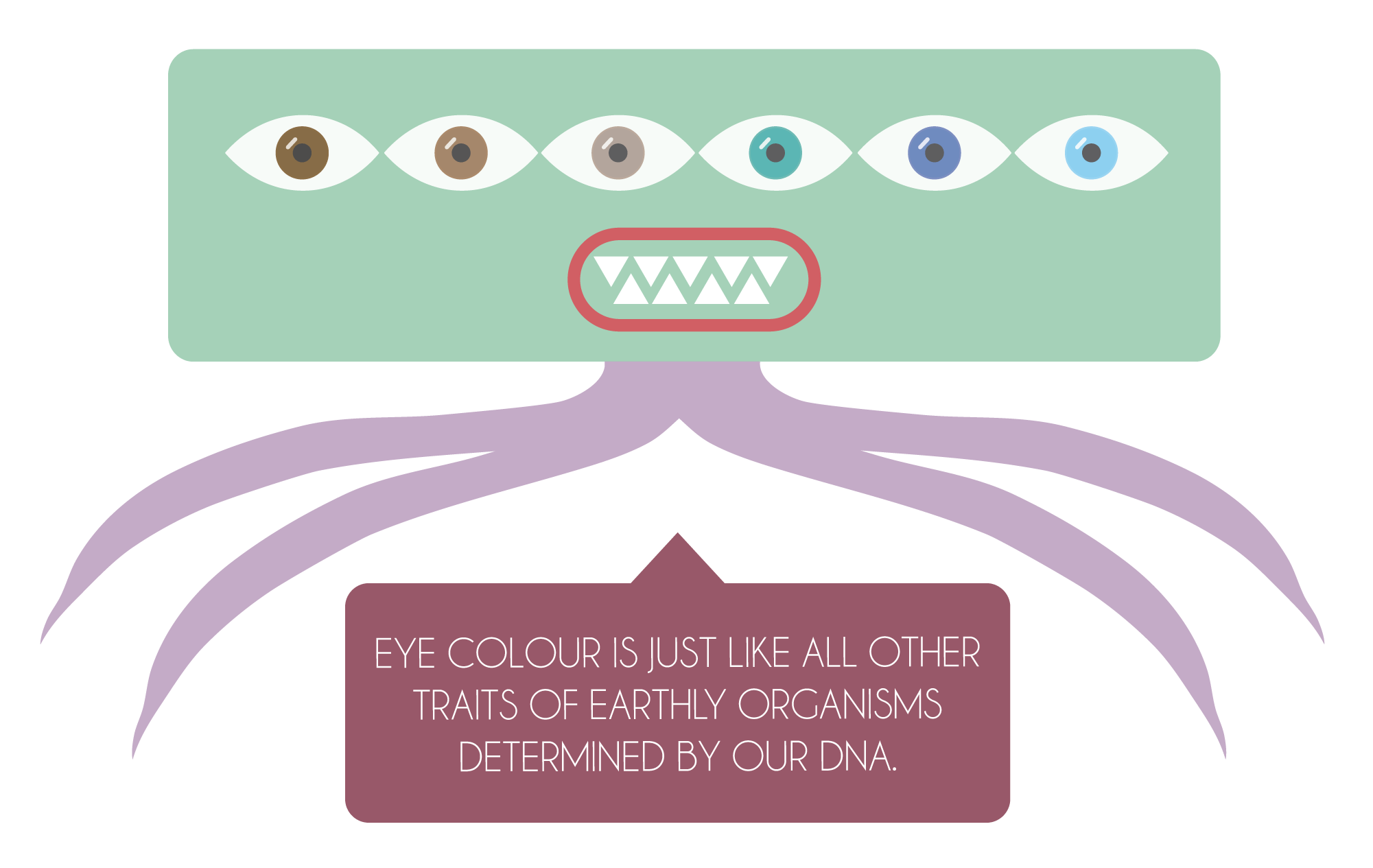
And every time an organism wants to make a copy of itself (reproduce), it has to copy its DNA into a new shell. It is like copying the control software of a computer into a new one. Modern complicated organisms achieve that by sexual reproduction – two individuals decide it would be a splendid idea to join their deoxyribonucleic acids into one and thus create a unique offspring, who combines the traits of their parents.
However, prokaryotic cells reproduce in a much more interesting way – they divide. Imagine suddenly splitting your body into two halves. Then, both of them would grow back up to form your entire body. This is exactly the kind of reproduction used by many ancient and today’s cells.
But the process of copying genetic information is not perfect. Whether DNA is copied by cell division or sexual reproduction, this process never evades various errors. Such errors can take up many forms – a disobedient particle inside your DNA finds itself in a wrong place or a certain segment of your DNA is copied multiple times. These errors are called genetic mutations.
Genetic mutations are the most important phenomenon related to evolution. You see, a new organism that is formed from a copied DNA strand is no longer identical to the original organism – its DNA is a little different because of mutations. We can see a great parallel again in our computers. Imagine changing some part of the system code of your computer – you find a line of code and do whatever you want with it. You can copy it, delete it or simply start typing random characters and hope for the best. Genetic mutations inside organisms are similar.
It should not come as a surprise that most genetic mutations are not really beneficial. An organism with a harmful genetic mutation usually perishes long before it is able to pass it on to its posterity. However, sometimes the opposite happens – a genetic mutation turns out to be advantageous. Within early organisms, such a mutation could have taken many forms. For instance, it could have caused that a cell produced a better cell wall or that it could utilize nutrients in a more effective way.
An organism with a profitable mutation not only survives, it is often more successful than its relatives without a similar mutation. Due to this fact, they are often able to reproduce better and thus pass the mutation to the next generation. Those then pass it on again and again, and the number of individuals with the mutation grows rapidly, until they outnumber those without the mutation.
Imagine that you are serenely manipulating with the code of your computer without any knowledge of programming languages, and by pure chance, you manage to create a code that makes the computer a thousand times faster. You then send this improved code to your friends, who apply this code to their own devices. The code will spread rapidly and before you know it, everybody has it – the old code will be gone forever, because it will have been eliminated by yours. Evolution works similarly, though in a considerably more complicated way.
Due to the omnipresent mechanism of evolution, early organisms did wonders. Some of them managed to directly utilize the sunlight using photosynthesis, others told themselves that it would be a swell idea to move onto dry land. The organisms with advantageous genetic mutations thrived, while others gradually perished.
The swift advancement of evolution was supported by a substantial factor – the early Earth was a particularly inhospitable place. Organisms that were not able to adapt enough were thus mercilessly obliterated. On top of that, prokaryotic cells knew a mesmerizing trick – horizontal gene transfer. Humans can pass on their genetic information merely vertically – to their children. But all the early organisms could give parts of their DNA to anybody. It is as if you were able to give your friend the color of your eyes or your height. Thanks to this feature, beneficial genetic mutations spread like wildfire throughout the early Earth, and prokaryotic organisms split into two primary groups – Archaea and Bacteria.
And what happened after that? For a long time, not much. If you are by any chance planning to go on a trip two billion years into the past to explore all the diverse species of organisms of the early Earth, you are free to cancel this journey right away. Two billion years ago, there was not a single organism that we would have be able to see with the naked eye – all of them were still trapped in the microscopic world. This absence of any advanced development is somewhat surprising given the fact that back then life had already existed for over a billion years.
However, over 1.8 billion years ago, a crucial reversal in the development of life occurred. Some bacteria got a great idea – to live inside of other cells. The first eukaryotic cells therefore saw the light of day.
If you point a microscope on any eukaryotic cell of your choice, you will see various objects performing diverse functions – organelles. At first sight, it might seem that each organelle is just a part of the eukaryotic cells. It has turned out, however, that some organelles used to be independent organisms that got mercilessly engulfed by an ancient cell.
After all, we can actually demonstrate that on the eukaryotic cells of the human body. You see, they contain organelles called mitochondria – necessary factories producing energy for our bodies. But all mitochondria are in fact descendants of ancient bacteria that were absorbed 1.8 billion years ago by a different cell, and together they formed eukaryotic cells. One might say that they must have started making themselves at home in our cells after such a long time. The opposite is true – they are still keeping a kind of distance from other parts of their host cells due to their own membrane. They even to refuse to give up their own DNA (the remaining DNA is located within the cell nucleus, but mitochondria do not let that happen to their DNA and are still keeping it in their own heart; it might almost seem like they are ready to pack their bags and leave their eukaryotic host anytime).
Even plant cells have their own independent visitors in the form of chloroplasts, which transform sunlight into chemical energy and thus produce carbohydrates. That means that plant cells are only able to perform photosynthesis due to the fact that one of their predecessors thought it would be a great idea to engulf a poor cyanobacteria.
Only with the arrival of eukaryotic cells did evolution finally build momentum. Eukaryotic cells brought order into the realm of genetics – they have cut down on horizontal gene transfer and learned to reproduce in an organized way using sexual reproduction. That has caused a true explosion in the diversity of the eukaryotic world.
Over 1.2 billion years ago, some eukaryotic cells decided to join into one complex unit and thus gave birth to the first multicellular organisms. 600 million year thereafter, the amount of oxygen in the atmosphere raised drastically. As a consequence, the ozone layer was created and started blocking harmful radiation from the Sun. Organisms could finally move onto dry land.
500 million years ago, the first plants, animals and fungi appeared. The world saw fish, sharks, beetles and many more complex animals. 270 million years later, the dinosaurs became the dominant vertebrates and ruled the lands. However, 65 million years ago, an event occurred that changed everything. A huge, ten-kilometer meteorite crashed into today’s Mexico and caused the ultimate downfall of dinosaurs.
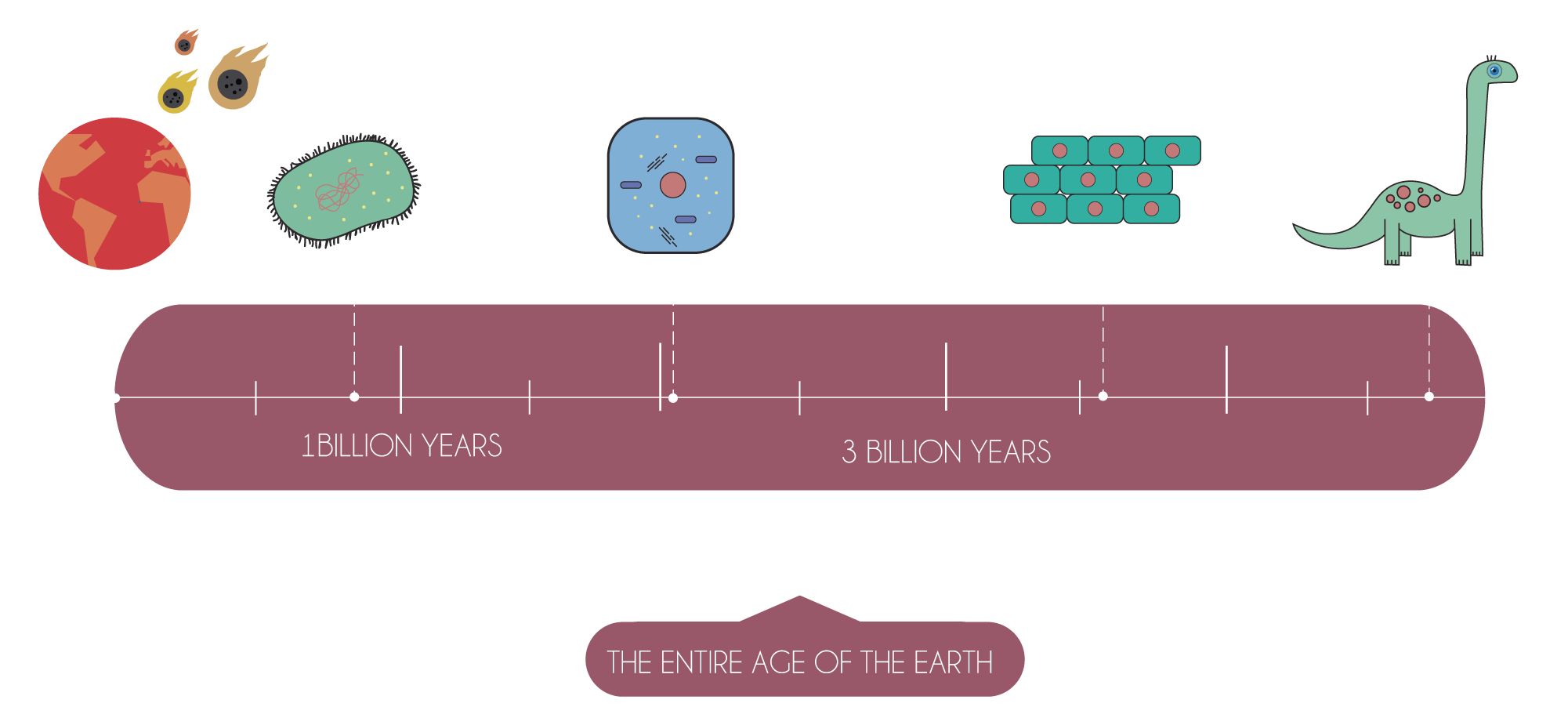
This seemingly tragic event, which mercilessly annihilated three quarters of all species on Earth, was undoubtedly the best thing that could have happened from our perspective. It overthrew reptiles and gave chance to a repressed group of animals known as mammals. Back then, mammals only constituted a negligible part of all animals and were trying their hardest to hide from the omnipresent dinosaur predators. However, once all the dinosaurs were gone forever, they seized the opportunity and swiftly took over the rule over the animal kingdom.
A tremendous evolutionary explosion followed, and mammals started taking many various shapes and sizes. Some went to become the greatest animals on planet Earth and created countless contemporary species like giraffes, elephants and bears. Others decided to stick with smaller proportion and evolved into today’s mice, squirrels and hares. Some even got the idea to submerge back into deep oceans and thus gave birth to intelligent dolphins and massive whales.
About 60 million years ago, the first primates appeared on Earth, serenely living in the forests. But seven million years back, a small group of higher primates somewhere in Africa made a significant decision – to forsake life in treetops and daringly go into open savanna. Here, its members evolved exceedingly large brains in proportion to the size of their bodies and became the most intelligent species on our planet.
And finally, just 200 thousand years ago, Homo sapiens came on the scene – humans were born. Some early humans decided to leave Africa and fled in all directions, on nearly every continents. The Earth was becoming crowded with people, which forced our predecessors to give up hunting and gathering and switch to agriculture. The first organized cities and civilizations were born.
Today, a few thousand years later, humans have gained a seemingly unshakeable position of the dominant species on Earth, residing on the very top of the food chain. And we owe all of this just to our immense curiosity and unprecedented intellect.
At first glance, it might seem that this was the goal of the billions of years lasting evolution – to create us, the smartest species on Earth. However, we should put aside our feeling of superiority over everything else and realize that evolution has no intentions. The only goal of the DNA molecule is to create an organism sufficiently adapted to its environment, so that it is able to pass on its genetic information to the next generation. It does not matter whether an organism comprises of just one primitive cell or takes form of a complex thinking being – form the perspective of evolution, you are just as successful as your pet, both of you have managed to win the harsh evolutionary fight against other organisms and our often very inhospitable planet.
Every organism you see around you (and even countless those you cannot see) is a product of a single successful evolutionary line. All of its ancestors have managed to pass on their genetic information to their descendants. It is fascinating when we realize that if just one of our ancestors failed, we would not be here at all. Every one of us is a product of many happy coincidences, without which we would not even have been born. In other words, if one of your fish ancestors were ruthlessly consumed by a hungry shark the day he was preparing to procreate another of your ancestors, the entire evolutionary chain would be irreversibly broken and your existence would simply be impossible.

 |
 |
 |
PREVIOUS |
SHARE |
NEXT |
THE INEVITABLE COLLONISATION OF THE COSMOS
The universe is an immensely inhospitable place. Our bodies are evolutionary adapted only to the characteristic conditions on the Earth, and a trip anywhere outside our tiny planet would without any doubt kill you. The human body is used to the tremendous pressure on the surface of the Earth – each second, a wall of air multiple kilometres high presses your body and you do not even feel it. In fact, we have got so used to the Earth’s atmospheric pressure that our bodies require it. In a near-perfect vacuum of cosmic space, where one can find no pressure at all, you would not survive for even two minutes – the air would get sucked out of your lungs in a flash and you would choke almost immediately. 1
And it would not be any better on alien cosmic objects – the Sun would immediately burn you with its gigantic temperature, on Mercury you would either get cooked or froze to death (it depends on which side of the planet you would find yourself), and Venus, for instance, would ruthlessly crush you with its unimaginably dense atmosphere.
It may seem that at least here on Earth we are safe – the temperature is just right, the atmospheric pressure is just the way our bodies like it and the same goes for the atmosphere’s composition. But the truth is that humanity is definitely not safe. Not even remotely.
I bet everybody has at some point heard about the Yellowstone National Park, a pride of the American state of Wyoming, teeming with measureless beauty. But not everybody knows what a monstrous object hides beneath the park’s beauty. Yellowstone is not just a national park. It is a huge active supervolcano.
A supervolcano is a gigantic volcano which is able to eject at least a thousand cubic kilometres of material from its heart. Imagine a region with the same area as London covered with 700 meters of dust – this is what supervolcanoes can do. It goes without saying that if Yellowstone exploded, it would be a total disaster. Most of the area of the US would be covered in a layer of dust multiple centimetres high. The gases from the volcano would get to the atmosphere and cause global cooling. The sunlight would not reach the surface of the Earth for ages. Raindrops would obtain a sinister black colour and would become strongly acidic. Humanity would be pushed to the very verge of extinction.
However, if a supervolcano eruption does not scare you enough, I have plenty of different catastrophes for you. If you remember the massive supernovae explosions from the previous chapter, then you might guess that it would not be a swell idea to be around one such explosion. A supernova located just a few light years from the Earth would decimate the ozone layer and quite possibly cause a massive extinction of species.
But we have only just begun. Do you remember the inglorious end of dinosaurs? The same could happen to us. Swarms of various meteorites constantly bombard our planet. However, most of them are too small and burn in the atmosphere long before they manage to wreak any havoc. But once in a few million years, a catastrophe strikes. A huge meteorite stealthily travels to the Earth and starts mercilessly falling down. It all culminates in an immense impact much stronger that the explosion of thousands of nuclear bombs. The meteorite buries into the Earth’s surface and causes massive tsunami waves and extensive earthquakes. Tons of material are heated to enormous temperatures and shot high into the atmosphere, where they turn back and start bombarding large portions of the Earth. Gigantic ash clouds are released into the air and the Earth is submerged into impermeable darkness for several years. Most species go extinct in the following days or weeks.
But there is even more. Other possible catastrophes include the exchange of the Earth’s magnetic fields, an unusually huge solar eruption, a stray black hole cruising our solar system, or a global deadly epidemic that may very well happen in today’s globalized society.
However, if you still do not believe me that any of these events would cause a tremendous catastrophe, we can peek into the past. Today, scientists document over twenty mass extinctions, all in the past 500 million years. But five of them deserve a special attention. Five tragic events which are known under an ominous nickname – the Big Five. I have already mentioned one of these colossal events – the asteroid impact at the very end of the Cretaceous period, which has annihilated over three quarters of all species, including dinosaurs.
What was the cause of the remaining four? Nobody knows. But one of them was so vast that it by far surpassed all the other extinctions of the Big Five – the Permian extinction. During this event, a whopping 95 percent of all species disappeared! Why? Nobody knows for sure.
If we take the total number of species that have cruised our planet and compare it to the number of species that inhabit the Earth right now, we find the shocking truth – more than 99 percent of all species that have ever lived are now extinct. All those millions of species I have already mentioned make up less than one percent of all the diverse organisms that the Earth has ever created.
But what does all of this mean to us? Will a similar extinction strike soon, causing us to perish? Probably not. Similar events are very rare and the probability of them happening in the near future is almost zero. It is possible that we will be just fine for another 100 thousand years.
But eventually, another extinction will without any doubt happen. Maybe in a hundred years, maybe in a million. And if humans are still walking on the face of the Earth when it strikes, it will not be good news for them.
Thus, if we want to save our species, we will eventually have to leave our tiny blue planet and find a new home. It is inevitable. And the sooner we make this huge step, the greater our chance of preserving.
It might not be obvious, but today we are nearly at the beginning of a new era. An era in which people will for the first time in history state a planet at the end of their address. And our first stop? Mars.
Even today, amazing plans to change the Red Planet beyond recognition are being developed. Scientists presume that once upon a time, Mars was not that different from the Earth. Its surface was covered by oceans of water and perhaps even held alien life. But then something went wrong, Mars lost most of its atmosphere and turned into a cold wasteland. If we managed to melt the water frozen on its poles and make its atmosphere denser, we would create an environment that is very similar to that on Earth. Yes, such an act will be immensely complicated and challenging, but the world’s greatest brains are already slowly planning to make it happen. 2
But if we want humanity to survive to the very end of the cosmos, the colonization of Mars will simply not be enough. In a few billion years, our beloved and faithful Sun will turn into a red giant and the Earth as well as Mars will become blazing spheres of molten rocks. On top of that, we will still be vulnerable to supernova explosions. One such explosion in the vicinity of the Solar System would influence all of its planets.
If we want to preserve our species as long as possible, there is only one solution – eventually, we will have to go towards new stars and find a home there. The future gives us only two options. Either we join the 99 percent species of our planet that have failed, or we retire from our blue shelter and head for the homes of the future. If we manage to do that, we will be the first species on Earth to extend its operation beyond the borderline of our planet. Who knows, perhaps we will be the first such species in the entire universe.

 |
 |
 |
PREVIOUS |
SHARE |
NEXT |
THE FERMI PARADOX
How is it possible that we have not encountered aliens yet? This seemingly asinine question was first asked in the previous century by an Italian physicists Enrico Fermi. However, Fermi’s question is completely justifiable. There are billions of galaxies in the universe, each of them hiding billions of stars, and each star can be orbited by up to several planets. Statistically, the Milky Way should therefore be inhabited by hundreds, if not thousands of civilisations much more advanced than we are. For many years, scientists have been listening to signals from space, observing all possible proofs of the existence of alien civilisations. So far without any success. The universe is unnervingly calm. Where are all the aliens?
Today, the question Fermi asked is one of the greatest unsolved mysteries of astronomy and has earned the nickname the Fermi paradox. After all those years, the question has passed through many curious brains, and many reasonable as well as crazy hypotheses have been created. Let us now explore some of them.
HYPOTHESIS NUMBER ONE
We are alone. Perhaps we are the product of a unique product of tremendous coincidences that has not occurred anywhere else in the whole gigantic universe. Do you remember the first living organism on Earth from the previous chapter? Maybe the birth of such an organism is so incredibly unlikely that it just did not happen anywhere else.
Or perhaps the universe is filled with unicellular organisms but only here on Earth did these organisms feel the need to create something more complicated. That would not be very surprising – after all, even our own prokaryotic cells took two billion years before they finally had the courage to a more complex eukaryotic cell, which is crucial for the development of intelligent life.
But maybe there are plenty of complex animals on the surface of other planets, but none of them are intelligent enough to communicate with us – perhaps the development of a highly intelligent species similar to Homo sapiens is unique, and other space objects are inhabited with animals that lack considerable intellect, just like here on Earth 65 million years ago.
However there are some grimmer possibilities as well. What if there were many intelligent species on various planets but every time a catastrophe occurred that destroyed them? There are many possible catastrophes, but one of them stands out amongst the others – self-destruction. Perhaps all civilisations in the universe unintentionally destroy themselves long before they are able to explore the surrounding space. A nuclear war or an irreversible change in a planet’s climate would safely cause such a destruction. After all, both of the scenarios threaten today’s humanity as well. Who knows, perhaps we will join these hypothetical unsuccessful civilizations that simply destroyed themselves.
Whatever the case, if this hypothesis were true, we would be completely alone in the entire universe. No exciting encounters with other thinking beings would ever happen.
HYPOTHESIS NUMBER TWO
There are intelligent civilizations in the cosmos but there are so few of them that we do not have the slightest chance of encountering them. If the closest advanced civilization inhabited one of the surrounding galaxies, we would most likely never be able to communicate with it in any way.
HYPOTHESIS NUMBER THREE
The universe swarms with civilizations, but aliens do not want to communicate with us. This hypothesis is the most disturbing. Why do they refrain from communication?
They might have a good reason. Perhaps our galaxy is ruled by an immensely advanced alien civilization, whose technological advancement we cannot even imagine. It might not be very wise to let such a civilization know that we exist by sending out radio signals in all directions. Maybe an intelligent rival like us is the last thing these superintelligent aliens would want. They might be determined to wipe out all potential threats in the form of smart organisms before they are able to advance enough. That would explain the absence of radio signals from alien civilizations – they might be all around us but are much more vigilant than us.
Even a famous physicist Stephen Hawking expressed his worries about perpetually sending various messages into the cosmos. He proclaimed that our potential encounter with a vastly advanced alien civilization might end up like the meeting of the civilizations of Europe and America in the late 15th century. We might become the modern Indians.
Silence and watchful observation may therefore be the wisest things to do today. We do not have any clue as to how it works in our corner of the galaxy, and it would be sad to be unpleasantly surprised as a result of our frivolity.
But perhaps aliens do not communicate with us for a completely different reason. What if they simply are not interested, since we are simply too stupid? When we go visit a zoo, we do not burn with desire to talk to a bear – even thinking about it seems a bit amusing. Not only is a bear unable to understand the theory of relativity, evolution, or gravity. It can also never understand even the simplest concepts that we find completely normal – going to school, driving by car or even brushing one’s teeth.
Maybe the intellectual level of aliens is so incomparable to ours that our primitive brains would never be able to understand anything about their lives – even their alien babies might be a thousand times smarter than the smartest people of the planet, and quantum mechanics might be just as easy for them as the equation 1 + 1 = 2. Aliens might perceive us as endearing ant-like creatures that are not even worth their attention.

 |
 |
 |
PREVIOUS |
SHARE |
NEXT |










